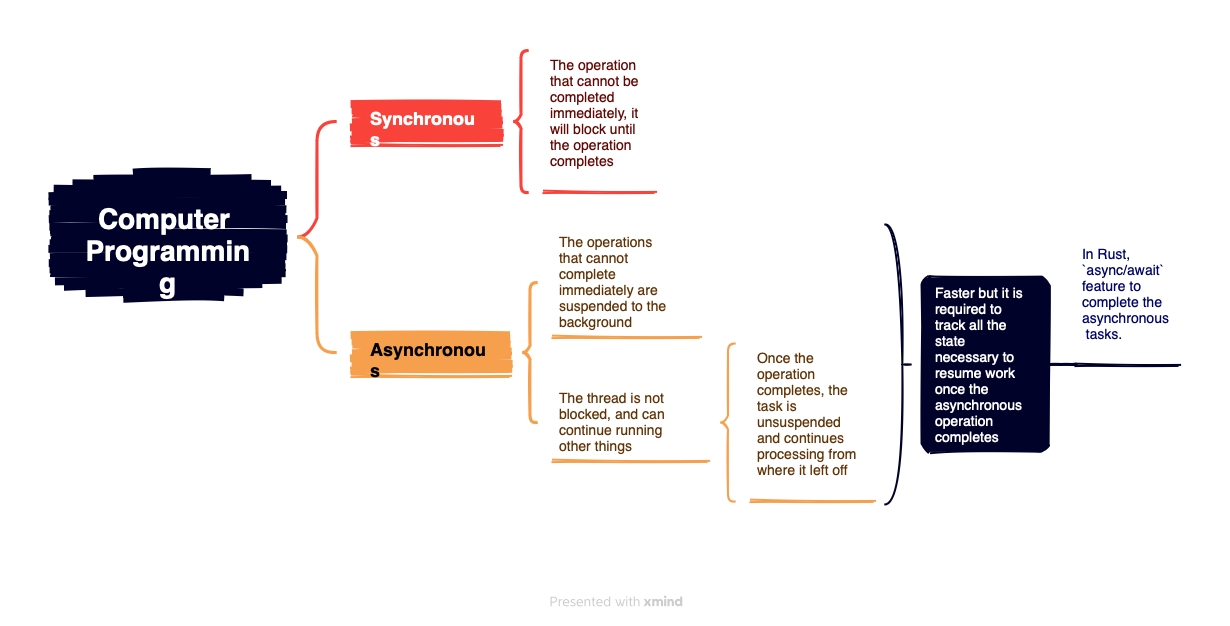📖Tokio
Crate tokio
In Rust, we call package as Crate. Crate tokio is a runtime for wrtiting reliable netwrok applications without compromising speed. And it is a event-driven, non-blocking I/O platform for writing asynchronous applications with Rust. It provides a rich set of components for building servers and clients.
Tokio provides a few major components:
A multi-thread runtime for executing components
An asynchronous version of the standard library
A large ecosystem of libraries
Tokio's role in your project
Asynchronous Ruse code does not run on it owns, so you must choose a runtime to execute it. The Tokio library is the most widely used runtime, surpassing all other runtimes in usage combined.
And Tokio provides the asyncchronous versions of the standard library.
When not to use Tokio
Tojio is designed for IO-bound applications where each individual task spends most of its time waiting got IO. If the only thing your application does is run computations in parallel, you should be using rayon.
Reading a lot of files.
Sending a single web request.
Working with Tasks
Asynchronous program in Rust are based around lightweigh, non-blocking units of execution called tasks.
The tokio::task module provides important tools for working with tasks:
The
spawnfunction andJoinHandletype, for scheduling a new task on the Tokio runtime and awaiting the output of a spawned task, respectively.Functions for running blocking operatiions in an asynchronous task context.
The tokio::task module is present only when the "rt" feature flag is enabled.
The crate Tokio provides a runtime for executing asynchronous tasks. Most applications can use the #[tokio::main] macro to run their code on the tokio runtime. However, this macro provides only basic configuration options. More advanced APIs for configuring and managing runtimes are provided by the tokio::runtime module.
Using the runtime requires the "rt" or "rt-multi-thread" feature flags, to enable the current-thread single-threaded scheduler and the multi-thread scheduler, respectively.
CPU-bound tasks and blocking code
Tokio is able to concurrently run many tasks on a few thread by repeatedly swapping the currently running task on each thread. However, this kind of swapping can only happen at .await points, so code that spends a long time wihtout reaching an .await will prevent other tasks from running. To combat this, Tokio provides two kinds of threads: COre threads and blocking threads.
The core threads are where all asynchronous code runs, and Tokio will by default spawn one for each CPU core. You can use the env variable TOKIO_WORKER_THREADS to override the default value.
The blocking threads are spawned on demand, can be used to run blocking code that would otherwise block other tasks from running and are kept alive when not used for a certain amount of time which can be configured with thread_keep_alive. Since it is not possible for Tokio to swap out blocking tasks, like it can do with asynchronous code, the upper limit on the number of blocking threads is very large. These limits can be configured on the Builder.
What is asynchronous programming?
Most computer programs are executed in the same order in which they are written. The first line executes, then the next, and so on. With synchronous programming, when a program encounters an operation that cannot be completed immediately, it will block until the operation completes. For example, establishing a TCP connection requires an exchange with a peer over the network, which can take a sizeable amount of time. During this time, the thread is blocked.
With asynchronous programming, operations that cannot complete immediately are suspended to the background. The thread is not blocked, and can continue running other things. Once the operation completes, the task is unsuspended and continues processing from where it left off.
Although asynchronous programming can result in faster applications, it often results in much more complicated programs. The programmer is required to track all the state necessary to resume work once the asynchronous operation completes. Historically, this is a tedious and error-prone task.

Compile-time green-threading
Rust implements asynchronous programing using a feature called async/await. Functions that perform asynchronous operations are labeled with the async keyword. For example, the connect function is defined like this:
The async fn definition looks like a regular synchronous function, but operate asynchronously. Rust transforms the async fn at compile time into a routine that operates asynchronously. Any calls to .await within the async fn yield control bakc to the thread. The thread may do other work while the operation processes in the background.
Using async/await
async/awaitAsync functions are called like any other Rust funciton. However, calling these funtions does not result in the funciton body executing. Instead, calling an async fn returns a value representing the operation. This is conceptually analogous to a zero-argument closure. To actually run the operation, you should use the .await operator on the retrun value.
Async main function
main functionThe main function used to launch the application differs from the usual one found in most of Rust's crates.
It is an
async fnIt is annotated with
#[tokio::main]
An async fn is used as we want to enter as asynchronous context. However, asynchronous functions must be executed by a runtime. The runtime contians the asynchronous task scheduler, provides evented I/O, timers, etc. The runtime does not automatically start, so the main funciton need to start it.
get transformed into:
Concurrency and parallelism
Concurrency and parallelism are not the same thing. If you alernate between two tasks, then you are working on both tasks concurrenctly, but not in parallel. For it to qualify as parallel, you would need two people, one dedicated to each task.
Tokio can run many tasks concurrently on a single thread.
Reference
Last updated
Was this helpful?